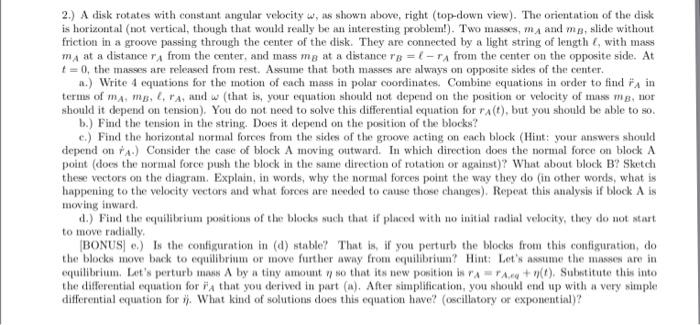Answered step by step
Verified Expert Solution
Question
1 Approved Answer
2.) A disk rotates with constant angular velocity w, as shown above, right (top-down view). The orientation of the disk is horizontal (not vertical,

2.) A disk rotates with constant angular velocity w, as shown above, right (top-down view). The orientation of the disk is horizontal (not vertical, though that would really be an interesting problem!). Two masses, m and mg, slide without friction in a groove passing through the center of the disk. They are connected by a light string of length (, with mass mA at a distance r from the center, and mass mg at a distance rp =-r from the center on the opposite side. At t=0, the masses are released from rest. Assume that both masses are always on opposite sides of the center. a.) Write 4 equations for the motion of each mass in polar coordinates. Combine equations in order to find FA in terms of m, mp, t, ra, and w (that is, your equation should not depend on the position or velocity of mass mg, nor should it depend on tension). You do not need to solve this differential equation for ra(t), but you should be able to so. b.) Find the tension in the string. Does it depend on the position of the blocks? c.) Find the horizontal normal forces from the sides of the groove acting on each block (Hint: your answers should depend on A.) Consider the case of block A moving outward. In which direction does the normal force on block A point (does the normal force push the block in the same direction of rotation or against)? What about block B? Sketch these vectors on the diagram. Explain, in words, why the normal forces point the way they do (in other words, what is happening to the velocity vectors and what forces are needed to cause those changes). Repeat this analysis if block A is moving inward. d.) Find the equilibrium positions of the blocks such that if placed with no initial radial velocity, they do not start to move radially. [BONUS] e.) Is the configuration in (d) stable? That is, if you perturb the blocks from this configuration, do the blocks move back to equilibrium or move further away from equilibrium? Hint: Let's assume the masses are in equilibrium. Let's perturb mass A by a tiny amount so that its new position is rA FA.eq + (f). Substitute this into the differential equation for FA that you derived in part (a). After simplification, you should end up with a very simple differential equation for ij. What kind of solutions does this equation have? (oscillatory or exponential)?
Step by Step Solution
There are 3 Steps involved in it
Step: 1

Get Instant Access to Expert-Tailored Solutions
See step-by-step solutions with expert insights and AI powered tools for academic success
Step: 2

Step: 3

Ace Your Homework with AI
Get the answers you need in no time with our AI-driven, step-by-step assistance
Get Started


